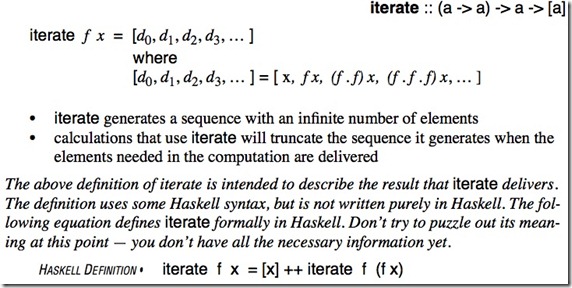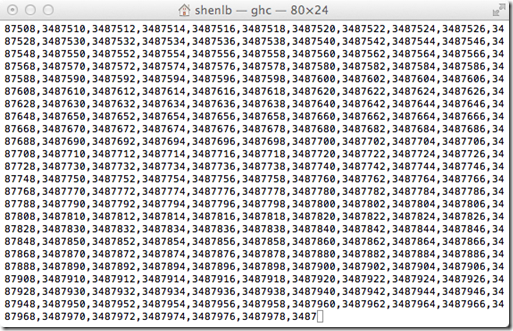《Two Dozen Short Lessons in Haskell》(Copyright © 1995, 1996, 1997 by Rex Page,有人翻译为Haskell二十四学时教程,该书如果不用于赢利,可以任意发布,但需要保留他们的copyright)这本书是学习 Haskell的一套练习册,共有2本,一本是问题,一本是答案,分为24个章节。在这个站点有PDF文件。几年前刚开始学习Haskell的时候,感觉前几章还可以看下去,后面的内容越来越难以理解。现在对函数式编程有了一些了解后,再来看这些题,许多内容变得简单起来了。
初学Haskell之前一定要记住:
把你以前学习面向过程的常规的编程语言,如Pascal、C、Fortran等等统统忘在脑后,函数式编程完全是不一样的编程模型,用以前的术语和思维来理解函数式编程里的概念,只会让你困惑和迷茫,会严重地影响你的学习进度。
这个学习材料内容太多,想把整书全面翻译下来非常困难,只有通过练习题将一些知识点串起来,详细学习Haskell还是先看其它一些入门书籍吧,这本书配套着学学还是不错的。
第十三章 Iteration and the Common Patterns of Repetition
这一章开始接触平常编程语言中不可想象的无限数据结构,利用iterate函数可以产生一个无限元素的列表。
iterate函数接受2个参数,假设为iterate f x
第一个参数本身是一个函数,输入为a类型,输出还是a类型。(这里以a是整数来举例)
第二个参数是一个值(类型为a)
输出为一个无限列表,列表中的元素都是a类型,第一个元素就是x,第二个元素是f x,第三个元素是f (f x),第四个元素是f (f (f x)......
例如:
函数f的定义如下:
f x = x + 2
那么iterate f 0就是输出结果:
[0, 2, 4, 6, 8, ...]
如果你在ghci交互窗口中试验该命令,则窗口中不停地输出偶数,直到你按CTRL+C才能打断它。
解释一下:
iterate f 0这个函数有2个参数,第一个参数是f,第二个参数是0
第一个元素就是0,第二个元素调用f 0(即2),第三个元素调用f 2(即4),以此类推
1 The iterate function
a delivers an infinite sequence as its value
b applies a function to the value that function delivers, over and over
c delivers its second argument as the first element of a sequence
d all of the above
2 What value do the following Haskell commands deliver?
HASKELL DEFINITION • add2 n = n + 2
HASKELL COMMAND • iterate add2 0
HASKELL COMMAND • iterate add2 1
a the biggest number that Haskell can compute
b nothing — they aren’t proper commands
c the number that is two more than the starting point
d one delivers the sequence of even numbers, the other the odds
3 Use the iterate function to generate the sequence [x0, x1, x2, x3, …] where x0 = 1 and xn+1 = 11xn mod 127.
a next x = x/127 * 11
iterate next 1
b next x = (11*x) ‘mod‘ 127
iterate next (1/11 ‘div‘ 127)
c next x = (11*x) ‘mod‘ 127
iterate next 1
d none of the above
=========================================================
答
案
在
下
面
=========================================================
1 d
iterate得到一个无限的序列
不停地调用函数f
第一个元素的结果作为输入,继续调用函数f,得到第二个元素
2 d
在Haskell中可以直接用列表写出一个无限序列:
[0, 2..]
也同样可以得到偶数的无限序列
同理,用[1,3..]可以得到奇数序列
3 c
这里实际上就是一个伪随机数生成器,x0就是随机数种子


